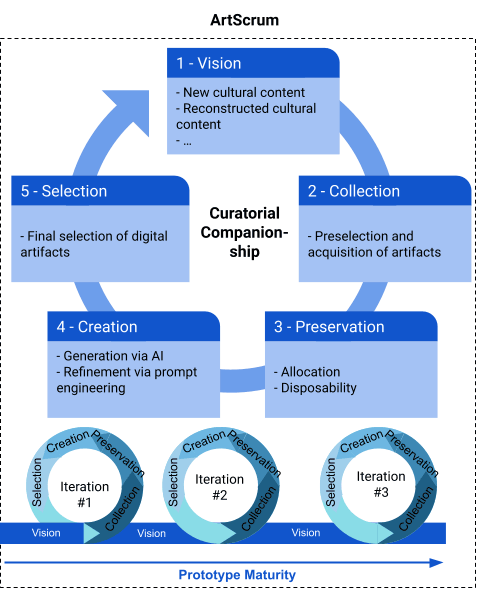by Thomas Ballhausen (University Mozarteum Salzburg) and Stefan Gindl and Markus Tauber (Research Studios Austria FG)
In this paper, we present a novel approach for the intense management of data and creation of digital, cultural artefacts. We propose using interdisciplinary synergies between two new concepts, cultural companionship and ArtScrum. The former is an approach to combine skills and expertise from various, possibly disjunct domains; the latter is a structured, iterative concept adopted from digital engineering and specifically adapted to the needs of digital art creation.
Based on our experiences and findings in the context of technology-driven, arts-based research projects [L1] and the need for customised, curated and generated cultural content, i.e. data, in various fields of application [1] we introduce “curatorial companionship” as a new framework that focuses on the management of high-quality digital cultural content throughout its life cycle. This includes creation (i.e. digitalisation and creation of culture with and through digitalisation), preservation (including categorisation), consumption, etc. Based on a broad understanding of culture [L2], the current technical possibilities and the resulting need for digitally customised cultural content, we advocate for data management that is effective in all phases of the life cycle of the respective digital cultural object or product. Even though the topic is broader, meaning more research to do in the immediate future, we present here an initial investigation on the aspect of the creation of culture with and through digitalisation. Central ideas are not only the understanding of generative AI applications as tools that are used within human-machine assemblages, but also the examination of the creation of new cultural content as well as the possibility of synthetic reconstructions of incomplete, unrealised or even stylistically alternative artworks and cultural objects (i.e. synthetic fictions). The framework described in the following is meant as a tool to support involved stakeholders from interdisciplinary backgrounds.
Curatorial Companionship
Curatorial companionship brings together the domain knowledge of diverse fields, which are required for the creation and management of digital artwork. Furthermore, it adopts a set of archival practices and data management processes, including (i) the collection and preservation of existing digital artefacts, (ii) the generation of content and its refinement, as well as (iii) the selection and access of the final artefact.
This results in curatorial companionship requiring skills including data management, advanced digital skills, and, most importantly, contextual knowledge. The latter is specifically relevant when dealing with cultural content. In a broader understanding of synthetic data that includes high-quality narratives and the generation of them, there is therefore not only the need for non-hierarchical principles of creatorship [2], but also the consideration of ethical principles to, e.g. avoid misuse [3]. An important aspect of how curatorial companionship creates cultural artefacts is described here as a process we define as ArtScrum.
ArtScrum - A novel methodological approach
Given the strong proximity to digital through the usage of tools such as generative AI (but not exclusively), we explore the adoption of the Scrum framework, a process management tool rooted strongly in software development. Scrum emphasises an iterative approach for the creation of digital artefacts, where consecutive prototypes undergo stringent inspection and adaptation before the final goal, the product, is reached. This stands in contrast to traditional, hierarchical approaches, where the product is defined in detail at the beginning. Since the creation of art is a non-linear process, we believe that ArtScrum is the ideal framework for the creation of art by generative AI. It aligns the practices of curatorial companionship, i.e. from the vision of (data) collection, preservation, creation (by generative AI) to the final selection of an artefact on a chain of iterative recursions, where the output of each preceding step becomes the input for the subsequent iteration (see Figure 1 for an overview). The last selection step marks the end of the process, where the final digital artefact is the result.

Figure 1: The iterative process of curatorial companionship in the methodology of ArtScrum.
A Use Case – Synthetic Fictions
A potential use case and experiment for the application of generative AI in a setting of curatorial companionship and ArtScrum is the creation of synthetic fiction. Based on the science-fiction novel Dune (1965) by Frank Herbert, which has received renewed widespread attention due to a cinematic adaptation in 2021, we will show two examples for our understanding of synthetic fictions. Referring to its reconstructive perspective, that is, the completion of incomplete, fragmented or even wholly unrealised works, we refer here to the failed film adaptation by avant-garde director Alejandro Jodorowsky in the 1970s. It is not surprising that this project, which despite its failure is relevant to art history, has already undergone a first visualisation using generative AI, albeit one that is limited in scope and aesthetic quality [L3]. A second example is the implementation of synthetic fiction in the sense of an alternative stylistic realisation, which clearly differs from the actual remake from 2021. In this case, the protagonists as well as the colossal landscapes created for the latest film adaptation were realised in the style of the equally nightmarish and aesthetically distinct works of H.R. Giger – one of the artists involved in Jodorowsky's failed project [L4]. Both examples, appealing in their different ways, not only point to the current developments in the design and production of individual cultural content, but also show us the necessities for an implementation of curatorial companionship, especially for large-scale projects and professional (re)use.
Links:
[L1] https://www.spotonmozart.at/
[L2] https://policytoolbox.iiep.unesco.org/glossary/cultures/
[L3] https://www.youtube.com/watch?v=qShRMiUggKE&t=2s
[L4] https://www.youtube.com/watch?v=KZd4pz8aEfs&t=249s
References:
[1] M. Tauber, et al., “Social inclusion, health and content”, ERCIM News, vol. 130, 2022. (online)
[2] K. El Emam, L. Mosquera and R. Hoptroff, Practical Synthetic Data Generation, O’Reilly, Sebastopol, CA, 2020
[3] L. Floridi, The Ethics of Information, Oxford UP, Oxford, 2013.
Please contact:
Thomas Ballhausen, Universität Mozarteum Salzburg











